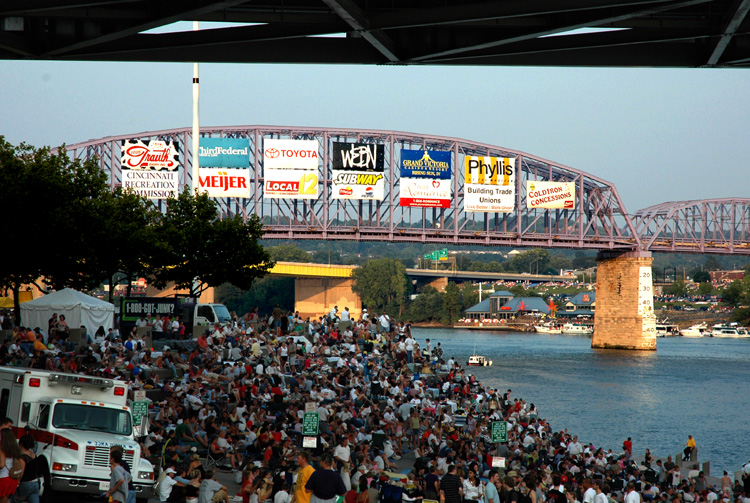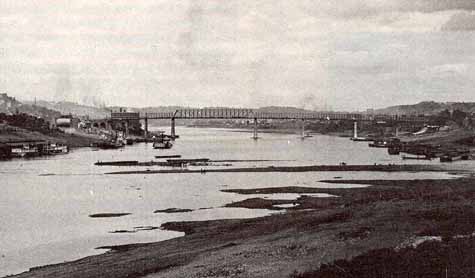Louisville & Nashville RR Bridge
The L&N Bridge opened in 1872 as the first Ohio River railroad crossing at Cincinnati. Whereas the Suspension Bridge has stood as a local icon since its 1867 opening, the L&N has stood nearby for just six fewer years in obscurity. It is the region's most eccentric bridge, with remnants of a half-dozen major modifications still visible today. Recently in 2002 it was heavily modified once again, painted purple, and reopened in 2003 as a pedestrian-only bridge. In 2006 The Purple People Bridge climb opened atop the bridge's trusses, an attraction inspired by the Harbour Bridge climb in Sydney, Australia. A major condominium development will break ground in 2007 on the Cincinnati side of the bridge, and streetcars might return to the bridge in the next five years as Phase II of the modern streetcar system currently under study for downtown Cincinnati.
L&N Bridge Timeline:1872: Cincinnati's first railroad bridge over the Ohio opened.
It was called the Newport & Cincinnati Bridge or simply Newport Bridge
and consisted of a single standard gauge railroad track.1897: At roughly the same time that the Suspension Bridge's deck was rebuilt,
the N&C's piers were widened and a more substantial truss replaced the
original. A 20ft. wide horse and cart path was added along with two
street car tracks. One of the street car tracks was sandwiched between
the cart path and railroad truss; the other was cantilevered off the
west side of the bridge, outside of the through truss.1904: L&N bought the bridge and renamed it.
The cart path was soon after repaved for automobiles.1940's: Streetcar service stopped soon after WWII.
The outside cantilever track was removed and the center streetcar track
become a pedestrian walkway.1950's: L&N and nearby Central bridge were made one-way each morning
and afternoon in order to increase rush hour capacity.1956: New looped entrance ramp was added from 2nd St.
1960's: Early I-471 plans called for its Ohio River crossing immediately adjacent
to or in place of the L&N.1987: Rail operations ceased. North approach viaduct was dismantled.
1990's: Light use by automobiles.
The bridge fell into disrepair and was threatened with demolition.2002: Bridge closed permanently to automobiles.
2003: Bridge rehabilitated, painted purple, and reopened as a
pedestrian-only bridge.
1880's photo of the L&N Bridge, as originally built
[click to enlarge]
The rivalry between Covington and Newport has festered for 200 years, and the fight over what became known as the L&N Bridge was one of their earliest battles. When the Cincinnati & Lexington Railroad was built to Covington in 1869, it had no bridge connection into Cincinnati. Covington's mayor prevented the sale of right-of-way for a bridge approach because the city would lose its status as the line's terminus. Neighboring Newport took advantage of the situation, granting right-of-way for the LC&L RR (Louisville, Cincinnati, & Lexington) from Latonia north on Saratoga St. to the riverbank. This line also built a short bridge over the Licking River. With the much larger dual track C&O Bridge, Covington answered with its own bridge in 1889. This line too required a bridge over the Licking River and the running of two parallel double tracked mainlines along Newport's southern edge.
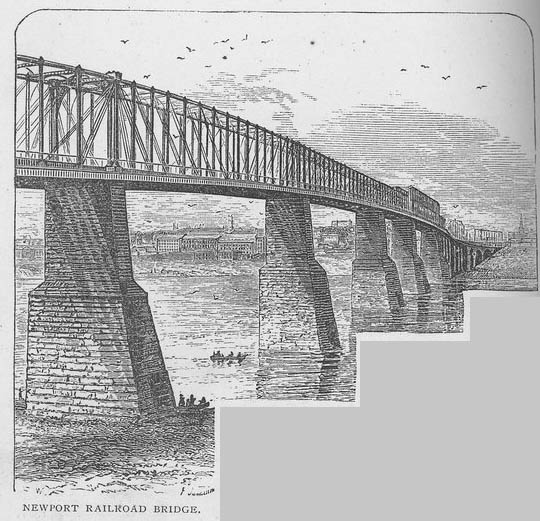
View of original bridge from Newport.
What was called the Newport and Cincinnati Bridge, or simply Newport Bridge, opened on April 1, 1872. It was initially owned by the Little Miami RR, because the LC&L used its terminal facilities on the Cincinnati side of the river. In the 1897 the bridge underwent a major rebuilding, with the original truss spans replaced by the dense Pennsylvania Pratt trusses seen today. This rebuilding maintained the number of spans and the length of each, but all piers and approaches were widened to accommodate an expanded deck width. The railroad track trusses were rebuilt to carry heavier modern equipment, a sturdier automobile side (previously a walking and carriage path) was constructed, and two entirely new street car tracks were added. The orientation of the street car tracks became the bridge's most unusual design feature -- the "east" track was sandwiched between the railroad track and automobile lanes, while the "west" street car track cantilevered off the west side of the bridge, outside of the through trusses. This unusual cantilevered design avoided a further widening of the piers and approaches.
In the late 1940's street car service stopped, the cantilevered west track and its supporting structure were removed, and the east track was turned into a pedestrian walk. The bridge closed to rail traffic in 1987 and deteriorated steadily during the 1990's as a lightly used automobile bridge. The L&N Bridge and the railroad itself were acquired by CSX, and although still popularly called the L&N, the bridge was officially renamed the CSX Bridge. After removing the tracks and dismantling the rail approach viaducts, CSX also stopped painting the railroad half of the bridge while the Kentucky Highway Department (which had been sold the automobile portion) continued painting the automobile side blue, resulting by the early 1990's in a blue and rust combination. Expensive lead removal prevented easy repainting of the rusting trusses.
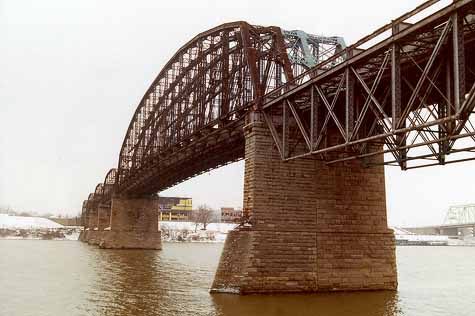
The rusted L&N in January 2001. Newport-on-the-Levee is
under construction in the background.
[Jake Mecklenborg]

Summer 2003 view of the L&N and its neighbors.
[Larry Stulz photo]
The curving and sloping path of the old northern railroad approach viaduct can still be seen in the stone piers, which were left standing after the approach viaduct was dismantled and are now obscured by the landscaping of Bicentennial Commons, a riverfront park built by Cincinnati in its bicentennial year of 1988. The roadway approach consists of a series of short sections built and rebuilt at various points in the bridge's history. Most distinctive of these sections are three giant brick arches dating from the bridge's original construction and 1890's rebuilding, which are unlike anything else in the Cincinnati area and amid the surrounding parks reference the industrial character of the city's 19th century riverfront. Today they form the border between the Serpentine Wall (a riverfront park opened in 1977) and Bicentennial Commons, and are put to good use shading vendors and parked ambulances during large events. The Newport approach consists of a series of smaller but similarly constructed arches, which were recently in 2000 turned into the automobile entrances to the Newport-on-the-Levee parking garage.
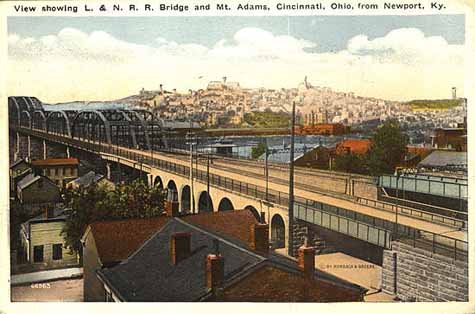
1920's view from Newport looking north. Newport-on-the-Levee now
stands in the left half of this photo.
Considering that virtually all shorter bridges over lesser bodies of water from its era have long since been replaced, it is remarkable that the crude L&N bridge survived. Yards could not be expanded nearby as was the case with the C&O and Southern Bridges to the west, and since Union Terminal was built to the west as well, the importance of the L&N's location diminished. Also with the failure to complete the Deer Creek Tunnel the need for higher capacity was not needed and the bridge was never double tracked like its neighbors. Also complicating the bridge's situation was the railroad's route through Newport, which ran straight down the center of Saratoga St. for several blocks. Any improvement would have required an expensive half mile viaduct. The Saratoga St. tracks were removed in the late 1980's when railroad operations ceased and were soon after replaced by a landscaped median. Land freed by the departure of the railroad was purchased by Trauth Dairy, whose delivery trucks use the line's old bridge over Alexandria Pike to connect the two halves of that company's property.
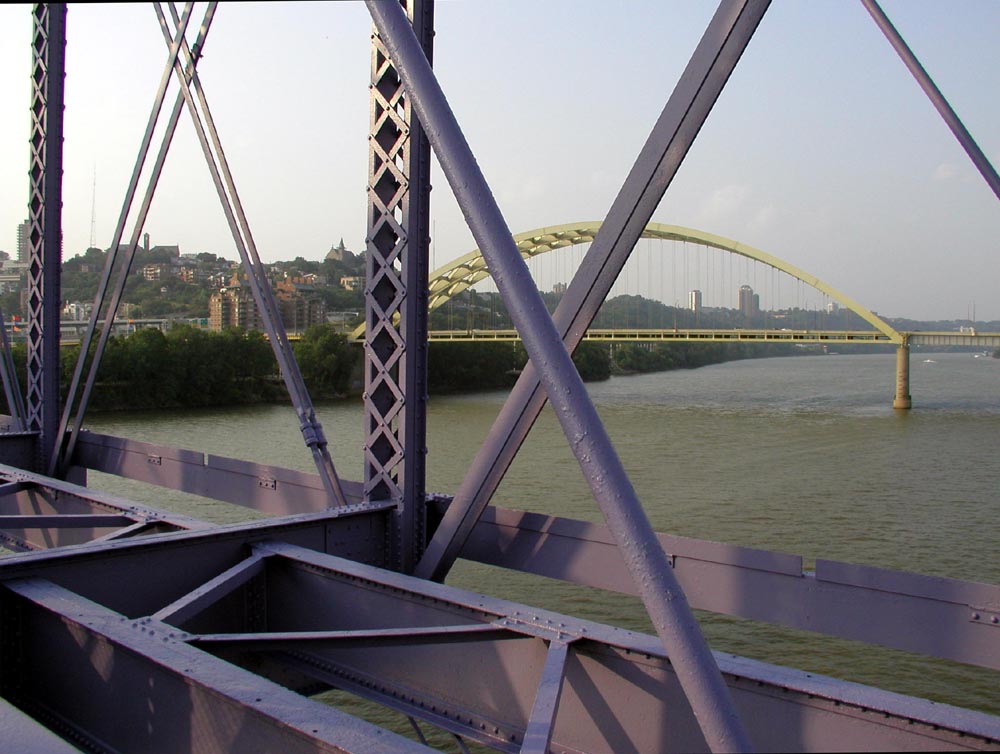
View from center pedestrian walk shows proximity of the I-471 bridge.
[Summer 2004 Jake Mecklenborg]
In the late 1990's developers announced plans for the Newport Aquarium and the Newport-on-the-Levee entertainment complex, to be built on the Kentucky riverfront between the Taylor-Southgate and L&N Bridge approaches. Additionally, light rail planners saw potential for the L&N to carry a new line to Newport. Suddenly there was considerable interest in saving the bridge, and on April 17, 2001 it was placed on the National Register of Historic Places. In 2001 it was closed permanently to automobiles. A year and $4 million later it reopened as a pedestrian-only bridge in May of 2003.
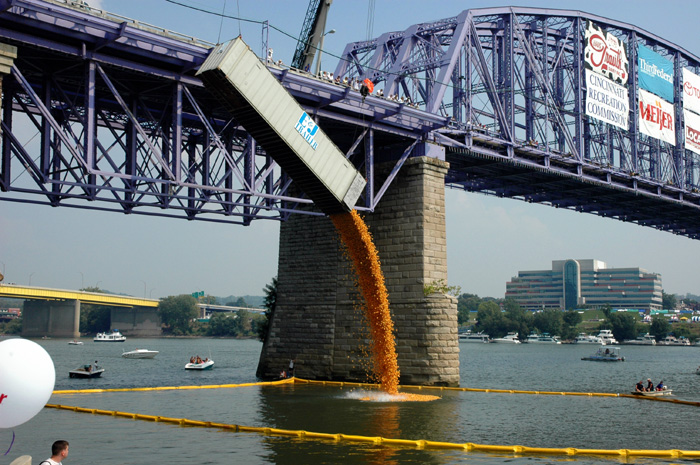
Thousands of rubber ducks are dumped from the bridge for the annual Rubber Duck Regatta.
[September 2004 Jake Mecklenborg]
Despite the refurbishment, the L&N is still undeniably the most eccentric bridge in the Cincinnati area. Nothing, it seemed, could have been more undesirable than the bridge's 1990's blue and rust period, but our wildest dreams could not have prepared us for a quarter mile of purple. In less conspicuous matters, the bridge continues its motley ways. The former center pedestrian walk has been maintained in the new configuration, meaning pedestrians commit to either the former automobile lanes or to the old center walk at the ends of the bridge. There are no connections between the two, although it seems that they could have been built at regular intervals at a minimal expense. The former Saratoga St. approach to the bridge has been taken over by the outdoor patio of Jeff Ruby's Tropicana restaurant.
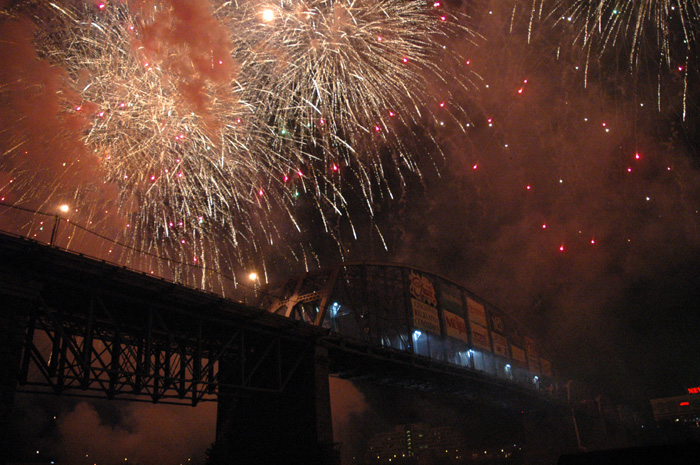
The L&N during the 2004 Toyota/WEBN Fireworks.
[September 2004 Jake Mecklenborg]
Photographs:
1. Historic L&N Bridge Photos and Post Cards
2. L&N Bridge Photos 1999-2001
3. 2003 photos -- General
4. 2003 Photos -- Newport approach
5. 2003 Photos -- Cincinnati approach
6. 2003 Photos -- Details
7. 2007 Photos
News Archive:
7/17/01 Cincinnati Enquirer Newport paves way for walkway
7/6/01 Cincinnati Post Bridge, Tunnel Named to Historic Register
5/20/01 Cincinnati Enquirer $4M grant to transform L&N Bridge into Pedestrian Walkway
